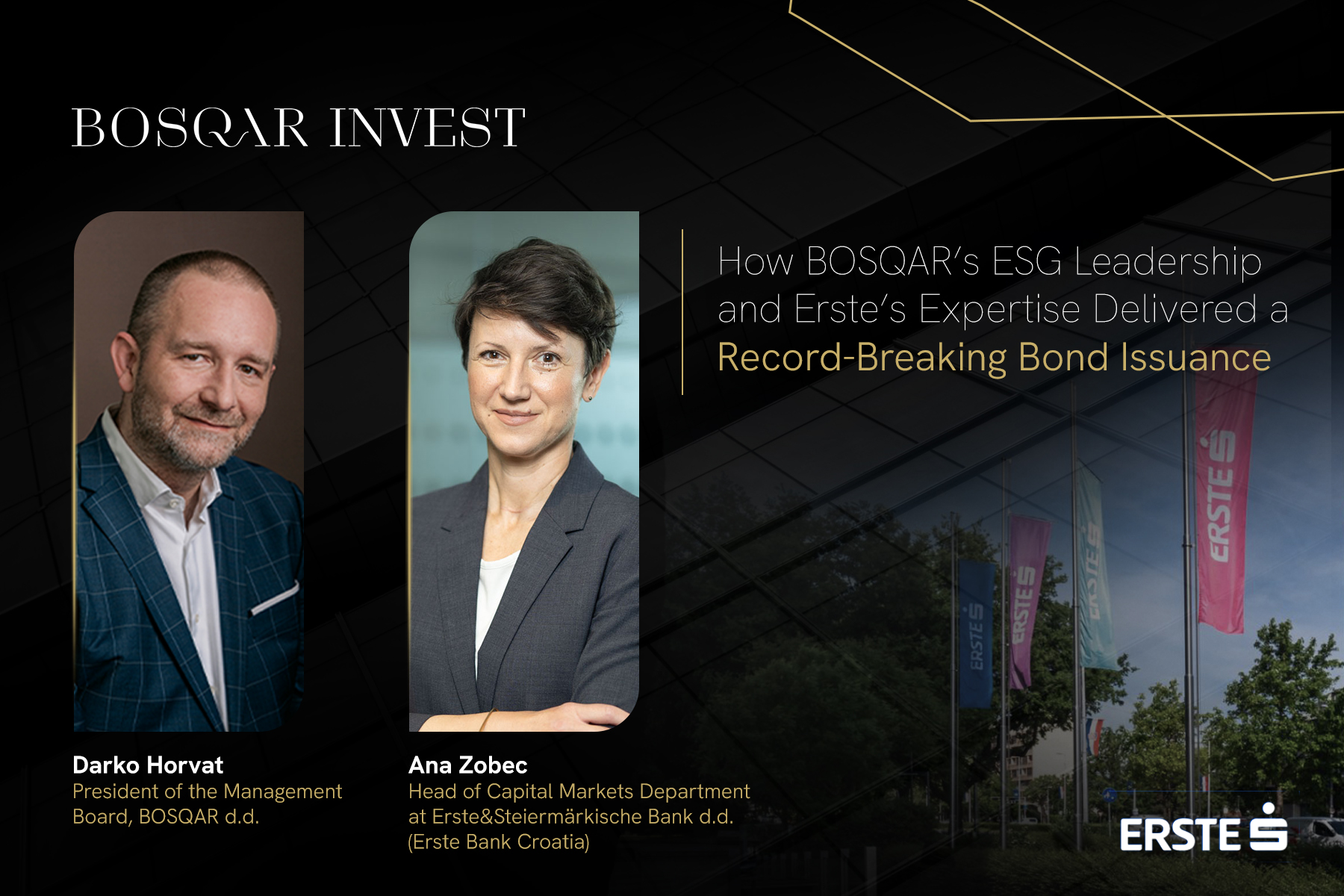
The article is adapted from the original content published by the newspaper Jutarnji list / Novac and translated from Croatian into English.
BOSQAR INVEST, one of Croatia’s fastest-growing business groups, has raised EUR 143.2 million through two tranches of sustainability-linked bonds (SLBs), marking the largest such issuance in the Croatian capital market by a privately-owned, non-banking company to date.
The issuance included EUR 105 million raised via public placement and EUR 38.2 million through private placement.
The public tranche offers a yield of 4.65%, with financing costs directly tied to achieving defined sustainability goals, most notably, a 36.4% reduction in absolute FLAG Scope 1 greenhouse gas emissions. The bonds mature in a single payment after seven years, with each carrying a nominal value of one euro. Bonds placed in the private placement mirror the maturity and terms of those offered publicly.
A track record of success in SLBs
Behind this milestone is a strategic alliance between BOSQAR INVEST and Erste&Steiermärkische Bank, which led the issuance process.
"We chose this bond because we’ve stayed committed to the direction we set for ourselves three years ago. Back then, we were the first company in Croatia to issue an SLB and the first to have the achievement of our environmental, social, or governance targets independently verified by an auditor," said Darko Horvat, President of the Management Board of BOSQAR d.d., the holding company of the BOSQAR INVEST group.
According to Horvat, the issuance process took over eight months and involved extensive due diligence by the European Bank for Reconstruction and Development (EBRD), along with a number of other investors, funds, legal teams, and creditors.
"We delivered outstanding results, but to achieve top-tier transparency, we had to introduce entirely new reporting structures, policies, and procedures to manage certain environmental risks. Since our first SLB, BOSQAR INVEST has changed significantly – we now think much more about sustainability across all levels of our business, with clearly established ESG KPIs that we regularly report to the financial community," he added.
A crucial moment in the process came when the company published a revised report, which confirmed that both KPI targets linked to the previous SLB had not only been met but exceeded in the performance observation year of 2024.
BOSQAR achieved a 32% reduction in Scope 1 and 2 emissions by the end of 2024, far surpassing its original 25.2% target set for 2027. Moreover, women made up 48% of management teams, one percentage point above the target for 2024.
"Investors saw that we know what we're doing, that we deliver on what we promise, and that we're serious about making the communities we operate in better places. When it comes to delivery, I’m proud that it’s always well above expectations – something that’s also reflected in the performance of our stock, which has seen exceptional growth since our IPO in 2019," Horvat added.
Record New SLB Issuance
The groups’ second SLB issuance drew participation from around 30 investors, including six banks: Erste&Steiermärkische Bank, NLB, UniCredit Group (Zagrebačka banka), Intesa San-Paolo (PBZ), and two others.
NLB played a key strategic role in Slovenia, where nearly 13% of the issuance was allocated. Croatian pension funds subscribed to almost 20% of the public placement, while several major insurance companies from Croatia, Slovenia, and international markets contributed more than 7% of the issuance.
A particularly noteworthy aspect was the EBRD’s role as the sole investor in the private tranche, reinforcing the long-term strategic partnership between the EBRD and BOSQAR. Together, the two have raised over €100 million to date through bond and equity issuances.
Erste’s Ana Zobec: Growing Interest in SLB Instruments
From the arranger’s perspective, the transaction illustrates the value of linking financial instruments to ESG principles.
"There is definitely interest in SLB instruments among both issuers and investors, but currently, the format doesn’t yet offer a pricing advantage," Ana Zobec, Head of Capital Markets Department at Erste Bank Croatia, said.
"It’s more about the positive image of a company that aligns its strategy with sustainable business models and embraces a form of ESG responsibility and ethics. The interest is still primarily driven by the credit story – the attractiveness of the company’s operations and the risk-return profile."
Zobec also noted that SLBs play a vital role in attracting international financial institutions, especially given the large potential investment volumes they command.
Horvat: SLBs Are Worth the Effort
Despite the success, Horvat believes that many companies in Croatia remain hesitant to issue ESG-linked bonds because the local market does not yet reward the added effort.
"Perhaps it's more accurate to say that issuers avoid them because, based on our experience, pricing in our region tends to remain the same even without the ESG component. But we believe the costs and effort behind these bonds are absolutely worth it – they’re a long-term competitive advantage," Horvat said.
In 2025 so far, ESG instruments account for 19% of corporate bond issuances in the eurobond market – down from a peak of 34% in 2022 and 24% in 2023. Still, the long-term outlook remains optimistic.
"Investing in sustainability requires initial adaptation, but the positive effects of green transformation far outweigh the costs. Over time, sustainable orientation will have an even more positive impact on company performance," Zobec said.
She emphasized Erste Bank’s active role as agent and arranger for its clients’ ESG-linked bonds, supporting both their sustainable business transformations and the broader development of the capital market in this segment.
"Although the global landscape is currently marked by geopolitical uncertainties, we expect the SLB format to grow in the medium term, fueled by decarbonization targets and regulatory measures, alongside the integration of sustainability into corporate strategy," Zobec concluded.





